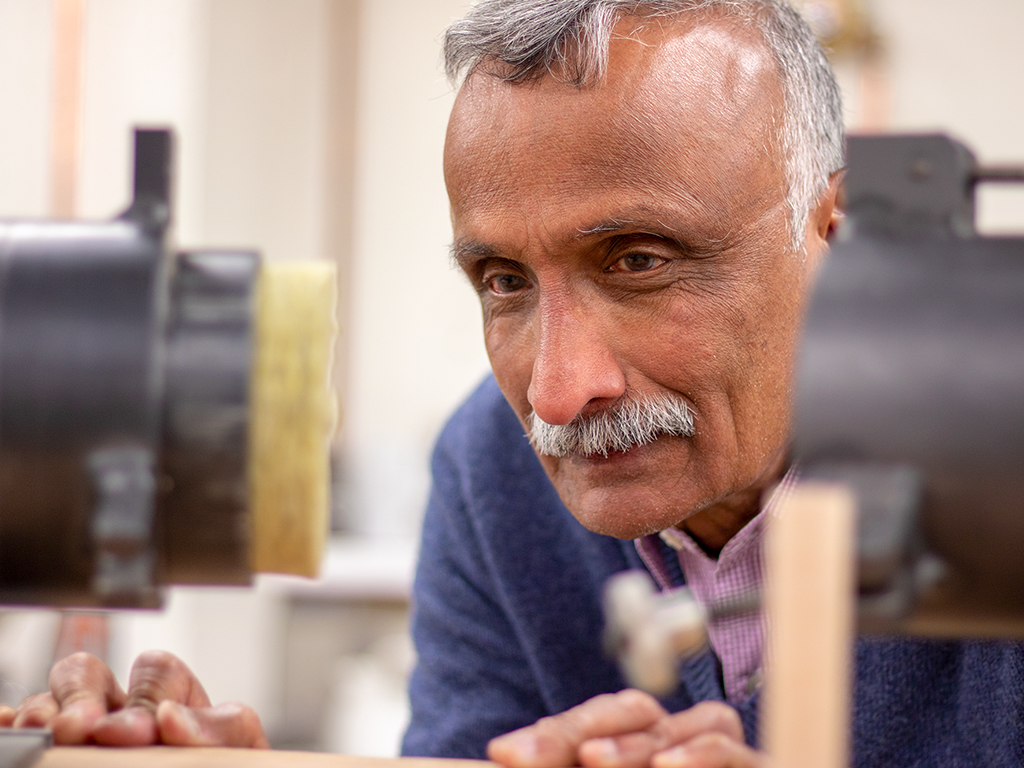Dr. Ramani Ramakirishnan Retires after 36 Years with DAS

From designing reactive mufflers to an acoustics room for NASA’s Orion (Manned orbit around Mars) Project, professor emeritus Dr. Ramani Ramakrishnan is retiring after 37 years at DAS amongst heartfelt congratulations from colleagues (external link) .
One of Dr. Ramakrishnan’s earliest designs was an underground bus shelter located in Ottawa’s vibrant St. Lawrence Market. Concerned about the noise levels caused by large buses sitting and idling, Dr. Ramakrishnan designed non-load bearing brick walls to dampen sounds for commuters. By slightly changing the architect’s design, the noise control measures performed better than expected.
Here in Toronto, Dr. Ramakrishnan in collaboration with Romain Dumoulin undertook the acoustic design of the music room at Burdock’s Brewery (external link) , a popular local bar, entertainment venue, and microbrewery. The space posed unique challenges due to shared walls with the bar area as well as the microbrewery unit:
“In order to achieve acoustic diffusion, a room was built into a room, so that no mechanical connection exists between the bar and music room. The ceiling hangs from vibration isolators, and the floor sits on rubber pucks specially designed for the space.” Read more about the unique space and its acoustical modelling here (external link) .
The M.S. Subbulakshmi auditorium in Chennai, India, is another career highlight and one which holds cultural significance for Dr. Ramakrishnan: “It was very close to my heart as the auditorium was built in memory of classical music singer Madurai Shanmukhavadivu Subbulakshmi, otherwise known as the ‘nightingale of India’.” In collaboration with local architects, the 340-seat auditorium is now a central hub for art and music which you can read more about here.
As Chief Acoustician, Dr. Ramakrishnan also helped design the largest vibration test chamber in the world for NASA’s Orion (Manned orbit around Mars) Project. Designed for a sound pressure level of up to 163dB, which is seven times louder than a jet engine, the chamber simulates the vibration conditions experienced during launch and ascent. The door is two feet thick, 52 ft high with 150 microphones.
“Everything needs to be tested in an electromagnetic chamber and a vacuum chamber; everything has to be shaken and tested in an acoustic room. Even the smallest satellite is very expensive - and when it leaves the atmosphere, a lot of noise (and therefore vibrations) result from the rocket. The vibrations can break it, which is why acoustic room testing is so essential to the design process. In order for NASA to send a manned orbit to Mars, the rocket will need to be very powerful. They will need to double launch it, which creates a huge amount of vibration and noise - this is why it is so critical to test payloads first.”
Drawing upon his spiritual and religious background, Dr. Ramakrishnan brought a deep sense of tolerance and respect into the classroom. “We all have a role to play - I am not superior to anyone or inferior to everyone; this is how I treat my students. I regard them as equals and as individuals who have something to teach me just as much as I have something to teach them. It is so important to prioritize understanding over performance.” During his last semester teaching, students sent a letter of thanks to the Dean expressing their appreciation for his welcoming and compassionate learning environment.
“My approach to meditation informs my approach to teaching: by going inward, you look at the world as an observer and not as a participant. You see the whole picture, ‘Why am I making a big fuss over this?’ As a teacher my first priority is to the students.” When students would focus on obtaining full marks, Dr. Ramakrishnan would reorient their attention to the importance of learning the material, and not grades.
“There is this famous allegory attributed to Ramana Maharshi, an Indian Hindu sage. An older man would ask him questions about the meaning of particular passages of scripture. He would ignore him and smile, and continue conversing with another younger student. He then looked up patiently at the older man and said: ‘Whatever I said so far is the meaning of scripture.’ So when students seem more interested in the grades than in learning, I react with patience: focus on understanding the subject, prioritize understanding over performance.”
Reflecting on over thirty five years at Toronto Met, Dr. Ramakrishnan reflects on the importance of ongoing, life-long learning and urges the architects of the future to concern themselves with global warming and climate change, and to remember to treat others with equal dignity and respect.